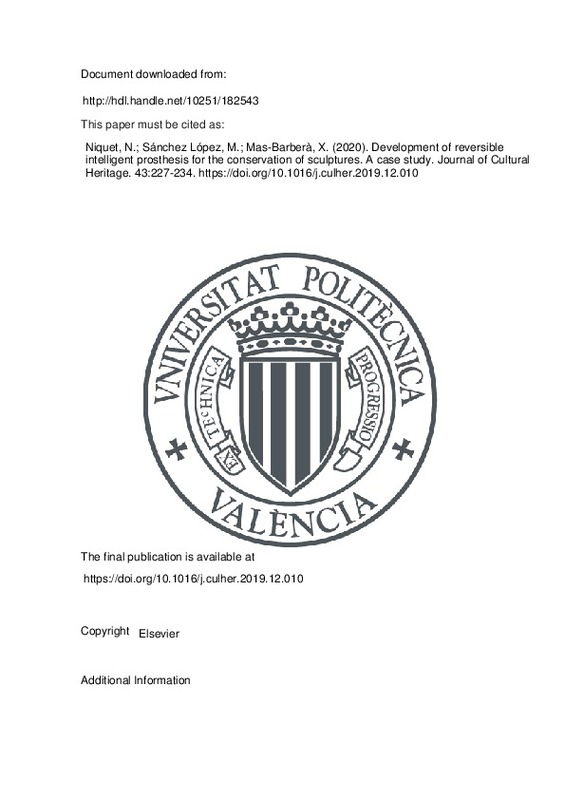JavaScript is disabled for your browser. Some features of this site may not work without it.
Buscar en RiuNet
Listar
Mi cuenta
Estadísticas
Ayuda RiuNet
Admin. UPV
Development of reversible intelligent prosthesis for the conservation of sculptures. A case study
Mostrar el registro sencillo del ítem
Ficheros en el ítem
| dc.contributor.author | Niquet, Nicolas-Didier
|
es_ES |
| dc.contributor.author | Sánchez López, Miguel
|
es_ES |
| dc.contributor.author | Mas-Barberà, Xavier
|
es_ES |
| dc.date.accessioned | 2022-05-11T18:06:20Z | |
| dc.date.available | 2022-05-11T18:06:20Z | |
| dc.date.issued | 2020-06 | es_ES |
| dc.identifier.issn | 1296-2074 | es_ES |
| dc.identifier.uri | http://hdl.handle.net/10251/182543 | |
| dc.description.abstract | [EN] The application of preventive conservation measures after restoration processes is a sustainable method to control and mitigate possible deterioration and damage to Cultural Heritage. Preservation requires monitoring physical parameters that influence the monument. This document presents the development of a versatile hybrid system based on a 3D printed prosthesis implanted with sensors to collect relevant environmental data. This novel system has been applied to a work of relevance, the Stone Sepulcher of Queen Mary of Castile, located in the Royal Monastery of the Holy Trinity of Valencia (Spain). The development of such an intelligent prosthesis aims to improve the conservation of a work of art. The system presented here is completely reversible, leaving any trace on the sculpture where it was inserted after removal. This intelligent prosthesis can monitor the environmental conditions and send them to a remote server in the cloud. The results have demonstrated the viability and suitability of the procedure and present an innovative solution applicable to other pieces of Cultural Heritage. | es_ES |
| dc.language | Inglés | es_ES |
| dc.publisher | Elsevier | es_ES |
| dc.relation.ispartof | Journal of Cultural Heritage | es_ES |
| dc.rights | Reconocimiento - No comercial - Sin obra derivada (by-nc-nd) | es_ES |
| dc.subject | Intelligent prosthesis | es_ES |
| dc.subject | IoT | es_ES |
| dc.subject | Advanced Cultural Heritage monitoring | es_ES |
| dc.subject | 3D virtual model | es_ES |
| dc.subject | 3D print | es_ES |
| dc.subject | Sepulcher of the Queen Mary | es_ES |
| dc.subject | Monastery of the Holy Trinity (Valencia, Spain) | es_ES |
| dc.subject.classification | PINTURA | es_ES |
| dc.subject.classification | ARQUITECTURA Y TECNOLOGIA DE COMPUTADORES | es_ES |
| dc.title | Development of reversible intelligent prosthesis for the conservation of sculptures. A case study | es_ES |
| dc.type | Artículo | es_ES |
| dc.identifier.doi | 10.1016/j.culher.2019.12.010 | es_ES |
| dc.rights.accessRights | Abierto | es_ES |
| dc.contributor.affiliation | Universitat Politècnica de València. Departamento de Informática de Sistemas y Computadores - Departament d'Informàtica de Sistemes i Computadors | es_ES |
| dc.contributor.affiliation | Universitat Politècnica de València. Departamento de Conservación y Restauración de Bienes Culturales - Departament de Conservació i Restauració de Béns Culturals | es_ES |
| dc.description.bibliographicCitation | Niquet, N.; Sánchez López, M.; Mas-Barberà, X. (2020). Development of reversible intelligent prosthesis for the conservation of sculptures. A case study. Journal of Cultural Heritage. 43:227-234. https://doi.org/10.1016/j.culher.2019.12.010 | es_ES |
| dc.description.accrualMethod | S | es_ES |
| dc.relation.publisherversion | https://doi.org/10.1016/j.culher.2019.12.010 | es_ES |
| dc.description.upvformatpinicio | 227 | es_ES |
| dc.description.upvformatpfin | 234 | es_ES |
| dc.type.version | info:eu-repo/semantics/publishedVersion | es_ES |
| dc.description.volume | 43 | es_ES |
| dc.relation.pasarela | S\401801 | es_ES |







![[Cerrado]](/themes/UPV/images/candado.png)

